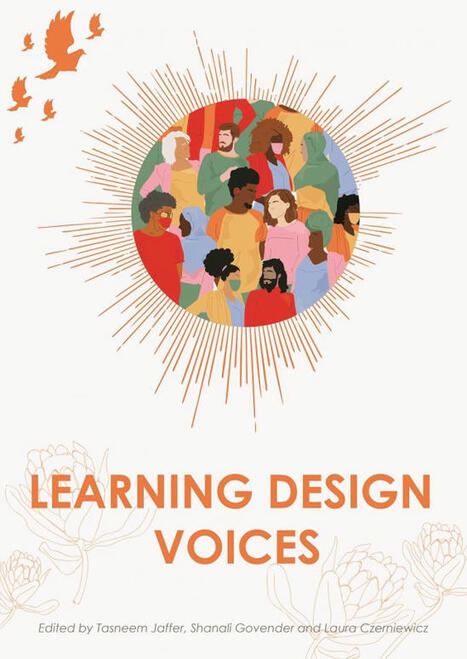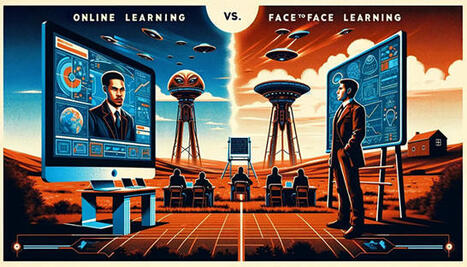In this provocation, Sue explores the field of learning design, where it has come from and how it has shaped the field. Questions of learning designer identity and roles come into play, and how this will look in the future in universities.
Get Started for FREE
Sign up with Facebook Sign up with X
I don't have a Facebook or a X account

 Your new post is loading... Your new post is loading...
 Your new post is loading... Your new post is loading...
From
h5p
The H5P Core Team is joining D2L. The organization responsible for H5P is no longer just a small team of 30 headquartered in Norway. The company behind H5P is now more than 1000 employees strong, with a global presence.
Experts call for better alignment between research and the classroom in Capitol Hill discussions.
Creating interactive auditing videos helped students contextualise a complex topic and provided feedback on their progress. Chu Mui Kim outlines how to do it
At the University of California, Irvine, a data-driven transformation is fostering a collaborative environment for informed decision-making. With high
The U.S. Department of Justice published its final regulation on web and mobile application accessibility under Title II of the Americans with Disabil
In this article, we'll explore why the ADDIE model remains a powerful tool for creating effective learning experiences.
Universities across Australasia regularly evaluate their Learning Management Systems (LMS) to meet the increasing digital teaching and learning demands. LMS reviews conducted approximately every five years or so are driven by factors such as pandemics, contract renewals, fiscal considerations, and the pursuit of optimal student online learning experiences. Recent trends show that Australian universities are conducting LMS reviews more frequently and transitioning to new LMSs at an accelerated pace (Phil, 2022; Sankey, 2023a). This is to ensure the LMS of choice meets the Next Generation Digital Learning Environment (NGDLE) functionality (Educause, 2018), is affordable, reliable and is still fit for purpose. While ongoing LMS reviews are common, there is a lack of published information on how higher education institutions undertake them. There was little available to unpack how best to engage in open, transparent, and aspirational conversation with staff and students about their experience with the LMS. As part of the review, even less was published about the dialogue on the future teaching and learning needs and the future of the LMS. To help address this gap in the literature, this practice-based paper reports on our approach and the steps taken to propose a unique two-phase / multi-stage model for reviewing an LMS and offers a useful checklist for those who may want some help getting started.
Discover Perusall — the interactive social learning platform where every student arrives prepared for every class. Boost engagement with automated tools and analytics for educators across 3000 institutions worldwide. Create a course today!
The Technology Enhanced Learning Accreditation Standards (TELAS) are a set of internationally benchmarked standards designed to assess the quality of online learning, particularly in relation to the tertiary sector. They provide institutions with the means to assess and evaluate the affordances of their online learning environments and thereby guide quality enhancements.
Sometimes the most effective path to progress is to capitalize on shared passion among individuals with a variety of skills and roles.
ACODE’s mission is to enhance policy and practice in Australasian higher education around technology enhanced learning and teaching at institutional, national and international levels through:
Peter Mellow's insight:
Best reads is ACODE’s newly release Benchmarks for Technology Enhanced Learning (V2.1) which now includes Technology Enhanced Learning Spaces.
See the resources & publications part of their site. |
Sometimes it feels as though UK higher education likes creating reports on blended learning just as much as Warner Brother’s liked making Police Academy films. The latest in the franchise is the cross-party think tank Policy Connect's report “Digitally enhanced blended learning”, a title that, with
Increasingly popular online platforms designed to measure student engagement pose a number of risks for children and offer questionable benefit to teachers, one expert has warned.
Peter Mellow's insight:
Engagement does not always = learning
Learning engineering combines theories from the learning sciences with problem-solving approaches from engineering, to create a process that can transform research results into learning action. Here, Ellen Wagner guides an exploration of this transformational process.
Peter Mellow's insight:
Reminds me of about a decade ago, when we talked about 'Learning Architects'!
The promise of digital credentials has had many people in education and employers excited for years. So why aren’t digital credentials everywhere by now?
dewavegas8788@gmail.com's comment,
July 4, 2024 7:50 PM
DEWAVEGAS ✅ SITUS TERPERCAYA ✅ LINK DAFTAR | LOG IN | ALTERNATIF ✅ RTP ✅ SLOT ✅ CASINO ✅ TOGEL ✅ 2024 ✅ 2025 ✅ THAILAND ✅ MALAYSIA ✅ INDIA ✅ FILIPINA ✅ INDONESIA ✅
✅ Link Daftar DEWAVEGAS �https://bit.ly/dwvegas99 ✅ Link Log in DEWAVEGAS �https://tinyurl.com/dwavegas998 PROMO SPESIAL CASHBACK DAN ROLLINGAN BONUS BEBAS BUY SPIN, BERLAKU UNTUK SEMUA PROVIDER GAME. TIDAK ADA BATASAN KEMENANGAN / WD. ✅ Minimum Deposit 5RB ✅ Tidak ada batasan kemenangan ✅ Pilihan metode deposit : BANK / E-WALLET ✅ Auto Payment untuk memudahkan deposit. SALAM JP & MAXWIN
Best practice in creating instructional videos that efficiently impart knowledge to students learning remotely, from Judy Brooks
If digital transformation is enabled by data and analytics and if data and analytics requires data governance, you can’t have digital transformation without data governance.
This paper develops the conversation focused on what professional competencies and skills learning design professionals (LDs) have or need to develop to meet contemporary learning design professional demands in organisations and learning institutions. In this paper, we used the lens of lifelong learning theory and skill analytics approach to develop a professional framework for learning design professionals. As people transition into thirdspace professional spaces like educational or learning design, a professional development framework can act as a reflective tool to support workplace learning and identity framing to look backward and forward to achieve personal and professional goals. A framework like this can potentially guide and support learning design teams and individuals to reflect on what skills they possess and identify gaps to plan how to address skill gaps through professional development, workplace learning and networking opportunities
The remote town of Leonora, more than 800 kilometres from Perth, is an unlikely technology hub, but its only school has been chosen to launch a new app aimed at preserving language and culture.
The global pandemic thrust online teaching to the forefront. Online enrollments rose while campus enrollments declined. Is face-to-face teaching doomed? Will virtual campuses be the norm? Is there no middle ground?
The educational inequity that Aboriginal and Torres Strait Islander people have experienced in higher education in Australia is replicated in virtual learning spaces, with generic models of online learning design taking little account of cultural factors that impact on learning. To counter this, new approaches to online learning design are needed that consider the experiences of Indigenous people. This article explores culture as a critical element of online learning design that enhances the learning experiences and outcomes of Indigenous people. The study reported in this article was conducted at a regional Australian university and was methodologically situated within an educational design research framework. Data were collected through the narrative method of yarning with 19 Indigenous students enrolled in a range of disciplines. From the data, 10 themes were developed, which guided the design of a learning design model and six preliminary design principles. The study contributes to the gap in the literature on learning design for Indigenous online higher education students. As the model and preliminary design principles are culturally situated at the site of the study, they need testing by educational designers and academics to ascertain their usefulness in other contexts.
We are better users of technology when we are thinking critically about the nature and effects of that technology. What we must do is work to encourage students and ourselves to think critically about new tools (and, more importantly, the tools we already use).
The COVID-19 pandemic significantly disrupted traditional methods of teaching and learning within higher education. But what remained when the pandemi |





























